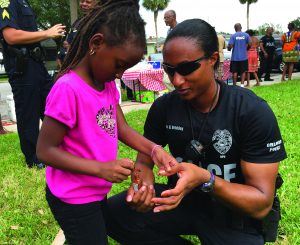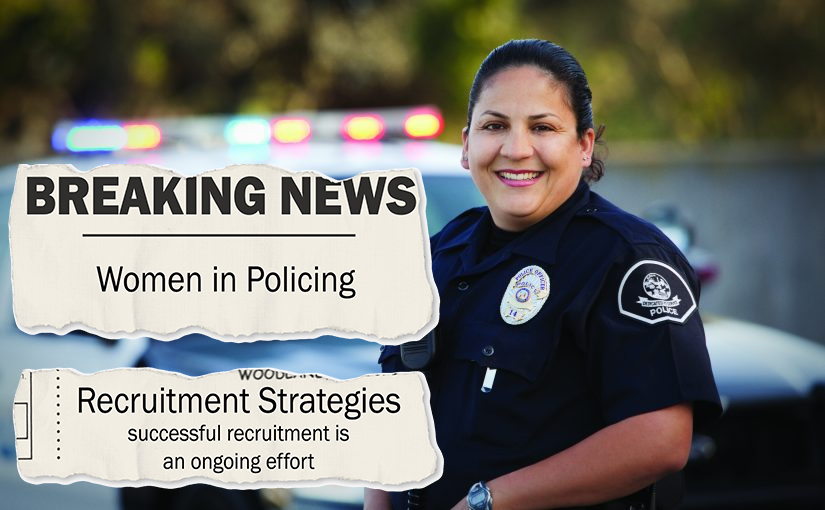Law enforcement is facing a crisis of public trust and confidence in the wake of highly publicized incidents that called into question the legitimacy of the profession. In the wake of the Black Lives Matter movement and the subsequent report by the President’s Task Force on 21st Century Policing, U.S. law enforcement leaders have acknowledged the need to diversify their agencies to reflect the communities they serve.1 In addition to addressing the need for an ethnically diverse workforce, there is another glaring reality in the lack of diversity in policing—the lack of women in their ranks. According to the U.S. Department of Justice Equal Employment Opportunity Commission’s {EEOC’s) report, Advancing Diversity in Law Enforcement, women account for only 12 percent of police officers across the United States.2
As many police agencies are struggling to attract qualified candidates, police chiefs should consider shifting their focus to anticipate the long-term impact of major social and cultural movements on their hiring strategies. During a time when every police contact influences the legitimacy of the profession, a broader perspective is needed. This perspective includes acknowledging the relevance of #MeToo and other social change movements, and how law enforcement leaders can adapt their succession plans to indemnify their municipalities.
Women in Policing – #MeToo
In 2017, the surge of the #MeToo movement was a remarkable time of social change. “One tweet ignited a firestorm that galvanized millions of survivors worldwide to share their stories of sexual harassment and sexual assault on social media.”3 The avalanche of allegations reached seismic proportions and delivered extraordinary impacts, reaching powerful men from Hollywood to Washington, DC, and beyond. As the downfall of high-profile celebrities and politicians dominated the headlines, so grew the wider conversation about the prevalence of gender inequities and sexual misconduct in male-dominated industries. According to a 2017 Pew Research Center survey, 62 percent of the women who work in male-dominated industries in the United States reported that sexual harassment is a problem in their industry, as compared to 46 percent of women working in female-dominated industries.4 Although the presence of sexual harassment in disciplines with women leaders strongly indicates it is driven by the misuse of power, and not just gender, male-dominant professions have a problem that is acute and in need of remedy. Law enforcement is one industry that was almost exclusively male at one time, but which has seen significant demographical change in the past 40 years.
Before the 1970s, nearly all criminal justice employees in the United States were men. Media representations, job descriptions, and institutional policies were gendered and tied to the male working-class culture. Since that time, though, equal opportunity legislation has sparked a series of legal challenges that discourage discriminatory or prejudicial behavior, creating more opportunities for women to enter law enforcement. Paradoxically, even with a pervasive effort to train the police in matters of workplace respect and harassment, cases of workplace and sexual harassment continue to soar, especially since the start of the #MeToo dialogue in 2017.

EEOC data reveal a 50 percent increase of sexual harassment lawsuits from 2017 to 2018. In addition, charges filed with the EEOC alleging sexual harassment increased by more than 12 percent from fiscal year 2017 to fiscal year 2018.5 In November 2008, a female officer in the Los Angeles (California) Police Department (LAPD) canine bomb unit was awarded $2.25 million in a sexual harassment lawsuit after male officers in her unit exposed their genitalia, made inappropriate remarks, and excluded her from training opportunities. Demonstrating the extent of the problem, LAPD paid out an additional $3.6 million to a male member of the same unit who was the only person to come to the defense of the harassed woman. The 21-year veteran suffered retaliation from his peers by being stripped of his rank and kicked out of the elite unit.6 This case and many others reinforce the reality that to ensure sexual misconduct does not continue to be a costly and systemic problem in the law enforcement profession, practices to recruit women must be examined by responsible leaders charged with protecting the integrity of their organizations.
The Implications of Underrepresentation
The Federal Bureau of Investigation reports that, in 2017, male officers outnumbered female officers seven to one. This means that women represent about 12 percent of all sworn law enforcement personnel in the United States—dramatically less than the participation of women in the overall U.S. labor force, estimated at 46.5 percent.7 The implications of this underrepresentation were documented in the International Association of Chiefs of Police Executive Guide for Addressing Sexual Offenses and Misconduct by Law Enforcement, which acknowledges that women, as a minority in the profession, are “sometimes subjected to sexually harassing behavior that seems designed to challenge their right to work.”8
According to professors of sociology from Harvard and Tel Aviv University,
Harassment flourishes in organizations where few women hold the core jobs. Fixing this is about finding power in numbers, not just in authority and hierarchy. Female firefighters, police officers, construction workers and miners are frequently harassed because they’re outnumbered. Again, the answer is to bring more of them into the ranks. In industries and workplaces where women are well-represented in the core jobs, harassment is significantly less likely to occur.9
Increasing the representation of women in police departments will change the climate of law enforcement agencies and address the pervasive issues of sex discrimination and sexual harassment. According to Dr. Kimberly Lonsway, the director of research for End Violence Against Women International,
[S]exual harassment is much more likely to occur in male-dominated workplaces and in fields that have been traditionally considered masculine.
Hiring and retaining more women within a law enforcement agency will obviously reduce the exposure to liability in this area by simply reducing the numeric under-representation of female officers.10
According to research published in the American Sociological Review,
Sexual harassment can serve as an “equalizer” against women in power, motivated more by control and domination than by sexual desire. The interviews point to social isolation as a mechanism linking harassment to gender non-conformity and women’s authority, particularly in male-dominated work settings.11
Underrepresentation of women in law enforcement leads to a power differential that can be rectified only through a greater numerical balance. Danish researcher Anette Borchorst, who has studied 150 cases of sexual harassment from the 1970s until today, concluded that sexual harassment “is not about sexual attraction, it is about power. The people who harass are those who have been longer in the workplace or those who have power, it lies in the hierarchy at work.”12 A 2017 Harvard Business Review article cites research to support the argument that numerical balance reduces the abuses of power, stating,
Greater numerical balance between people of different groups constrains the abuses of power: Those from less powerful groups have more allies, they are more likely to be watchfully present in the contexts in which the powerful abuse power, and they are more likely to feel empowered to speak truth to power.13
Although the issue of disparate treatment can exist with any minority culture in professional life, the added dimension of sexual harassment translates to a need to proportionately increase in the presence of women in law enforcement to alter the status quo. Law enforcement leaders reflecting on the need to increase the numbers of women in their ranks might feel they are already working as hard as possible on the issue. Unfortunately, though, many of the traditional recruiting approaches do not attract qualified female candidates.
Why Traditional Recruitment Strategies Don’t Work
A 2010 RAND survey of police officer and sheriff’s deputy recruits assessing ways to refine the field’s recruitment practices and increase diversity in public safety organizations revealed that female recruits regarded public service as the primary motivation for entering law enforcement and that power and authority inherent in the job and law enforcement’s military structure were less likely to be motivating factors for women than men.14 Traditional recruiting materials and messaging at recruitment booths, however, do not always emphasize the public service aspects of law enforcement.
Kathleen Spillar, executive director of the Feminist Majority Foundation contends,
Too many police recruiting campaigns feature slick brochures and billboards focused on adrenaline-fueled car chases, SWAT incidents and helicopter rescues—the kind of policing featured in television dramas and that overwhelmingly appeals to male recruits. In reality, 80 percent to 95 percent of police work involves nonviolent, service-related activities and interactions with people in the community to solve problems—the kind of policing that appeals to women.15
 Additionally, the President’s Task Force on 21st Century Policing recognized the emphasis that some law enforcement agencies have placed on the violent, dangerous nature of the profession—as opposed to officers’ role as “guardians” of the community—can serve as an obstacle to attract individuals from underrepresented communities, including female recruits.16 The RAND survey also revealed that women perceive the fitness requirements to be a larger barrier to joining law enforcement organizations as compared to male recruits, noting, “In some departments, certain elements of the physical abilities test, those that can be taught in the academy or those that have less bearing on most police work still continue to be the established standard in hiring practices.”17
Additionally, the President’s Task Force on 21st Century Policing recognized the emphasis that some law enforcement agencies have placed on the violent, dangerous nature of the profession—as opposed to officers’ role as “guardians” of the community—can serve as an obstacle to attract individuals from underrepresented communities, including female recruits.16 The RAND survey also revealed that women perceive the fitness requirements to be a larger barrier to joining law enforcement organizations as compared to male recruits, noting, “In some departments, certain elements of the physical abilities test, those that can be taught in the academy or those that have less bearing on most police work still continue to be the established standard in hiring practices.”17
In 2018, then-LAPD Assistant Police Chief Michel Moore (now the agency’s chief of police) offered his opinion about gender stereotypes still being a major issue in hiring:
I think there are still gender barriers in our organization because we still live in a society where, when it comes time to staying home with a four-year-old child who can’t make it to pre-school or who has to be picked up, generalizing, our society tends to look at women to take that role.18
The implicit bias Moore describes can impact recruiting campaigns, emphasizing the importance of creating diverse recruitment teams and staffing recruitment booths with female officers, a simple first-step measure that is often overlooked. There are, of course, also more structured and effective ways to increase the numbers of female officers in any police organization.
Law enforcement agencies should recognize that successful recruitment is an ongoing effort and should not be limited to the period immediately preceding an examination or creation of job openings.19 One part of an effective recruiting campaign to increase gender diversity in organizations is to select locations for outreach that have a greater population of women. For instance, some large police agencies currently concentrate most of their recruiting efforts on military bases; however, although this approach may generate some qualified candidates, it is extremely limited when trying to recruit women because the military has very low numbers of women.
Recommendations
It is true that many barriers exist that undermine diversity in recruiting and hiring. There are, however, steps an agency can take to attract and retain “highly qualified workforces that better reflect the communities they serve.”20 There are five primary ways to balance the scales:
-
-
- Develop a recruiting plan that encourages women to consider policing as a profession.
- Change the messaging in recruiting material away from the emphasis on physical skills.
- Assemble a diverse team of department and community members to explore recruiting opportunities and structures.
- Ensure candidates understand and can achieve success in physical aspects of the testing process.
- Adopt policies that are more family friendly.
-
Develop a Recruiting Plan
Agencies should develop a specific recruiting plan that emphasizes the agency’s desire to significantly increase the number of women in its ranks. This is consistent with guidelines published by the Commission on Accreditation for Law Enforcement Agencies (CALEA) that established an expectation that an agency’s workforce would be “representative of the available workforce in the agency’s service community relative to its ethnic and gender composition” and that if any group is underrepresented, “the recruitment plan will include proactive steps to encourage members of that group to seek employment opportunities.”21
Modify the Message

The underlying messaging about the nature of the job in recruiting materials should be revised. The National Center for Women & Policing developed a comprehensive manual, Recruiting & Retaining Women: A Self-Assessment Guide for Law Enforcement, to assist law enforcement agencies in efforts to hire and retain more female employees. The manual recommends a review of the agency’s written job descriptions and recruitment materials to eliminate gender bias, noting,
[J]ob announcements based on those descriptions for entry-level law enforcement officers continue to place a heavy emphasis on physical attributes over other skills…This traditional portrayal of police work will most likely screen out qualified women as potential applicants.22
The job description should describe the tenets of community policing and emphasize public serve philosophies in addition to traditional law enforcement duties.
Form a Diverse Recruiting Team
Agencies should form a diverse recruitment team of employees and members of the community to develop a recruitment campaign committed to increasing diversity in the organization. In 2018, the Pleasanton Police Department (California) formed a race- and gender-diverse recruitment team consisting of a cross-section of the organization that was charged with identifying opportunities and outreach strategies for increasing diversity in the organization. Female members of the recruitment team were surveyed to determine how they first learned of jobs with the law enforcement agency, what attracted them to their job, and what they find most satisfying about their careers. This information was extremely useful in developing a recruitment strategy that included female officers at all job fairs and community events and targeted varied recruitment locations, such as community colleges, to reach a greater number of qualified female applicants. In the first year following the inception of the recruitment team, the Pleasanton Police Department had a substantial increase in applications by female candidates.
Facilitate Success in Testing
The agency should facilitate programs and services aimed to ensure candidates understand the physical requirements of the job. Female recruits are more inclined than male recruits to report concerns about difficulties meeting fitness requirements. One way to alter this perception is to assess the utility of fitness requirements tested during the application process, and whether or not those skills (such as rescue drags and wall climbs) could instead be acquired and practiced in the academy. Another approach may be to offer exercises classes or some sort of pre-academy “boot camp” to prepare recruits to meet an agency’s physical standards.23
Port of Seattle, Washington, Police Chief Rod Covey shared a story about his daughter and how it changed his view on recruiting women. She did not pass the police officer physical test and was planning to give up on her dream of becoming a police officer when Covey intervened by hiring a trainer to help his daughter increase her upper body strength. Two months later, she successfully passed the physical test for a police officer position. Covey said,
My point in sharing this story is that I think we need to look at our standards and whether they make sense. We also need to look at programs that will allow our recruits, especially female candidates, to build their confidence—to offer training in how to complete the testing process, give them coaching, and help them to meet the requirements.24
Modify Policies to Be Family Friendly
To successfully recruit and retain women officers, agencies should adopt policies that support pregnancy and parenthood without compromising police operations, unfairly burdening employees, or violating antidiscrimination law. The International Association of Chiefs of Police says the most frequent reason women gave for resigning from law enforcement jobs was “family/children/birth of child.”25 Although the U.S. federal Pregnancy Discrimination Act does not require employers to offer maternity benefits to make it easier for pregnant women to work and to return to work, it is beneficial for agencies to accommodate pregnant women and to highlight these practices during recruitment outreach. Other ways to assist employees include providing adequate maternity leave, light-duty assignments, maternity uniforms and body armor, deferral of in-service training, continuation of benefits and seniority credits while on leave, and flexible schedules upon return to work.26
When considering the low number of sworn female personnel, administrators may cite a lack of interest from female candidates. Administrators who accept this as the reason for female underrepresentation fail to recognize the necessity of proactive recruiting efforts and the success these efforts will have in increasing the number of female applicants.
Conclusion
To maintain a healthy work environment, in which all individuals are treated with respect and dignity, law enforcement leaders must make responsible decisions now to prepare for a future free of gender inequities and sexual misconduct. Forecasting tools to anticipate social and cultural movements will present opportunities for agencies to discuss their succession plans to support a gender-balanced workforce governed by policies that uphold fairness and equity.
Implementing strategies for the recruitment of women must be strongly considered as leaders critically scrutinize their work environments to determine if a cultural reform is needed. The #MeToo movement calls for progressive leaders to move beyond responding to incidents of workplace sexual harassment and focus their efforts on eliminating the inequities in the system that make women vulnerable to sexual harassment and discrimination in the first place. 🛡
Notes:
1 Final Report of the President’s Task Force on 21st Century Policing (Washington, DC: Office of Community Oriented Policing Services, 2015).
2 U.S. Department of Justice (DOJ) and the Equal Employment Opportunity Commission (EEOC), Diversity in Law Enforcement: A Literature Review, 2015.
3 Shanon Lee, “Will the #MeToo Movement Lead to Lasting Social Change? Six Women Weigh In,” The Lilly, October 18, 2018.
4 Kim Parker, “Majority of Women in Male-Dominated Workplaces Say Sexual Harassment is a Problem in Their Industry,” FactTank, Pew Research Center, March 7, 2018.
5 Kari Paul, “One Year After Weinstein and #MeToo, Sexual Harassment Financial Settlements Have Soared,” MarketWatch, October 7, 2018.
6 Victoria Kim, “Jury Awards Damages to Officers,” Los Angeles Times, November 13, 2008.
7 FBI, “Full-Time Law Enforcement Employees by Population Group: Percent Male and Female, 2017,” 2017 Crime in the United States, Table 74; Claire Zillman, “Women’s Representation in the Workforce May Never Equal Men’s,” Fortune, January 31, 2017.
8 IACP, Addressing Sexual Offenses and Misconduct by Law Enforcement: Executive Guide (Alexandria, VA: IACP Law Enforcement Policy Center, 2011).
9 Frank Dobbin and Alexandra Kalev, “Training Programs and Reporting Systems Won’t End Sexual Harassment. Promoting More Women Will,” Harvard Business Review, November 15, 2017.
10 Kimberly Lonsway et al., Hiring & Retaining More Women: The Advantages to Law Enforcement Agencies, (Beverly Hills, CA: National Center for Women & Policing, 2003).
11 Heather McLaughlin, Christopher Uggen, and Amy Blackstone, “Sexual Harassment, Workplace Authority, and the Paradox of Power,” American Sociological Review 77, no. 4 (August 2012): 625–647.
12 Mari Lilleslatten, “Sexual Harassment Is About Masculine Power,” Kilden, January 17, 2018.
13 Dacher Keltner, “Sex, Power, and the Systems That Enable Men Like Harvey Weinstein,” Harvard Business Review, October 13, 2017.
14 Laura Werber Castaneda and Greg Ridgeway, Today’s Police and Sheriff Recruits: Insights from the Newest Members of America’s Law Enforcement Community (RAND Corporation Center on Quality Policing, 2010).
15 Katherine Spillar, “How More Female Police Officers Would Help Stop Police Brutality,” Washington Post, July 2, 2015.
16 Final Report of the President’s Task Force on 21st Century Policing.
17 Castaneda and Ridgeway, Today’s Police and Sheriff Recruits.
18 Police Executive Research Forum (PERF), “Police Leaders Discuss Challenges in Recruiting at PERF Town Hall Meeting in Nashville,” Subject to Debate, June 2018.
19 National Center for Women & Policing, Recruiting and Retaining Women: A Self-Assessment Guide for Law Enforcement (Beverly Hills, CA: National Center for Women & Policing, 2001).
20 DOJ, EEOC, Diversity in Law Enforcement.
21 National Center for Women & Policing, Recruiting and Retaining Women.
22 National Center for Women & Policing, Recruiting and Retaining Women.
23 Castaneda and Ridgeway, Today’s Police and Sheriff Recruits.
24 PERF, “Police Leaders Discuss Challenges in Recruiting at PERF Town Hall Meeting in Nashville.”
25 Karen Kruger, “Pregnancy Policy: Law and Philosophy,” Chief’s Counsel, Police Chief (March 2006).
26 National Center for Women & Policing, Recruiting and Retaining Women.
Please cite as
Maria Munayer, “Police Hiring in the #MeToo Era,” Police Chief online, July 17, 2019.



